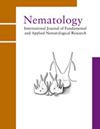一种简易的抑瘿试验方法的建立及其在杀线虫剂筛选中的应用
IF 1.2
4区 生物学
Q2 ZOOLOGY
引用次数: 0
摘要
对于发现控制南方根结线虫的候选杀线虫剂的筛选试验来说,观察根上胆汁形成的盆栽试验是现实的,因为它可以覆盖线虫的生命周期和测试化合物的广泛作用模式。然而,它的运行既需要时间也需要劳动力。本研究的目的是开发一种基于植物的筛选方法,使其能够在几乎没有土壤吸附测试化合物的条件下,容易地定期观察根胆形成的进展。作为土壤的替代材料,将用于种植蔬菜幼苗的岩棉基质与营养液一起使用。在相同的基质上观察胆囊形成可能持续3-4周。用这种方法,标准杀线虫剂,如磷噻嗪和氟吡喃,对胆囊的形成有明显的抑制作用。在接种300只第二阶段幼鱼(基质)−1后21天,它们的ED50值分别为0.0034 mg(基质)-1和0.0035 mg(基体)−1。用该方法对常规杀菌剂和杀虫剂进行了筛选。在一些产品中观察到了活性,如聚氧化氧,在25 mg(底物)−1时显示出100%的控制,这比标准杀线虫剂的剂量高得多。本研究开发了一种简单的测试方法来评估隐翅虫对胆汁形成的抑制作用,并将其应用于杀线虫剂的筛选,证明了其有效性。本文章由计算机程序翻译,如有差异,请以英文原文为准。
Development of a simple test method for inhibitory effect of gall formation on Meloidogyne incognita and its application to nematicide screening
For a screening test to discover nematicide candidates to control Meloidogyne incognita, a potted plant-based assay to observe gall formation on the root is realistic because it can cover the nematode life-cycle period and a broad range of mode of actions of tested compounds. However, both time and labour are needed for its operation. The objective of this study was to develop a plant-based screening method enabling easy periodical observation of the progress of root gall formation under almost no soil adsorption conditions of tested compounds. As an alternative material for soil, rockwool substrate for growing vegetable seedlings was used with a nutrient solution. Observation of gall formation on the same substrates was possible for 3-4 weeks. With this method, standard nematicides, e.g., fosthiazate and fluopyram, provided clear inhibitory effect on gall formation. Their ED50 values at 21 days after inoculation of 300 second-stage juveniles (substrate)−1 were 0.0034 mg (substrate)−1 and 0.0035 mg (substrate)−1, respectively. Furthermore, conventional fungicides and insecticides were screened with the method. Activities were observed in some products like polyoxins, which showed 100% control at 25 mg (substrate)−1, a considerably higher dose than that in standard nematicides. This study developed a simple test method for evaluating inhibitory effect on gall formation by M. incognita and proved its usefulness by applying it to nematicide screening.
求助全文
通过发布文献求助,成功后即可免费获取论文全文。
去求助
来源期刊

Nematology
生物-动物学
CiteScore
2.60
自引率
33.30%
发文量
67
审稿时长
3 months
期刊介绍:
Nematology is an international journal for the publication of all aspects of nematological research (with the exception of vertebrate parasitology), from molecular biology to field studies. Papers on nematode parasites of arthropods, and on soil free-living nematodes, and on interactions of these and other organisms, are particularly welcome. Research on fresh water and marine nematodes is also considered when the observations are of more general interest.
Nematology publishes full research papers, short communications, Forum articles (which permit an author to express a view on current or fundamental subjects), perspectives on nematology, and reviews of books and other media.
 求助内容:
求助内容: 应助结果提醒方式:
应助结果提醒方式:


